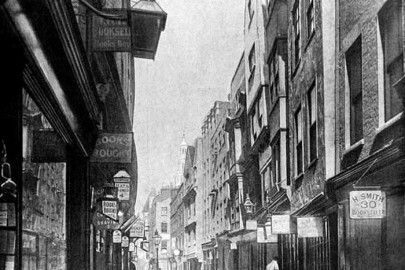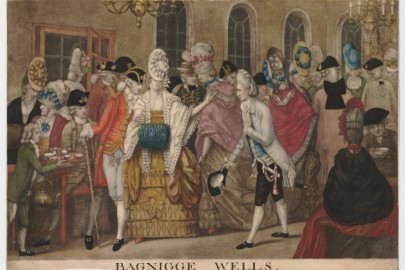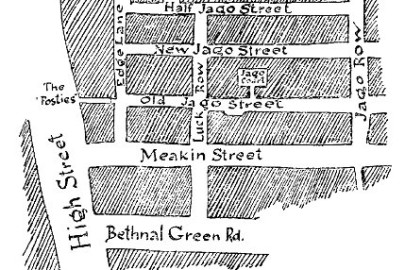… and also bunyips, whangdoodles and snollygosters – it’s Mr Slang’s guide to monsters…
The usual taxonomy of slang is derived from searching themes and is, like much else, dependant on what one did at some earlier, quite possibly ill-worked out and at all too premature a stage. The childhood, as it were, of the research, the infancy of the database. Now, 20 years on, you regret the oversights, the miscues, the faltering steps, but the brute is gross now, what was young is now mossybacked and sometimes life is quite literally too short. The tagging, those codes that render useful searches possible could have been so much better. I can search on much but what I have not indexed cannot be consulted, or not without effort, and I failed, how I regret it now, to index for ‘animals’. Dogs, cats, rats, the usual, whether domestic, en-zooed, in the wild or whatever, can all be called down but every species, from aardvark (a fool) to zebra (a referee), demands individual keyboarding and if you don’t know they’re listed then how can you search. On the other hand, since for once my defining has been relatively consistent, I can search for monster. And myth. To that end I offer a brief tour of slang’s teratology:
bobo-johnny [? Yoruba buburu, bad, evil + Johnny, a man] [20C+] (W.I.) 1 a bogeyman, an imaginary monster conjured up to frighten naughty children. 2 a peasant, an unsophisticated country person.
bunyip [SE bunyip, ‘the Aboriginal name of a fabulous monster inhabiting the rushy swamps and lagoons in the interior of Australia’ (OED)] [mid-19C+] (Aus., Sydney) an impostor, a pretender, humbug; also as adj.
cockatrice [SE cockatrice, a hybrid monster with head, wings and feet of a cock, terminating in a serpent with a barbed tail] 1 [16C–mid-19C] (also cock-trick) a prostitute [such a monster can kill with a mere glance + pun on cock, the penis + fem. sfx -trix; J.O. Halliwell, editor/reviser of Robert Nares’ Glossary (1822), suggests that it ‘seems to be applied especially to a captain’s concubine’]. 2 [18C–19C] a baby [the monster is born from an egg].
dragon 1 [17C–early 18C] a slattern, a promiscuous woman. 2 [1950s–60s] an old prostitute. 3 [1960s] (N.Z.) a wife.
dragon 2 [the image of St George and the dragon engraved on the obverse of the coin] [19C] a sovereign.
dragon 3 [backform. f. chase the dragon, to inhale the smoke of heated, liquified heroin] [1980s+] (drugs) heroin.
dragon 4 [1980s+] (US) a (large) penis.
■ drain the dragon to urinate
dragon 5 [such a person ‘breathes fire’] [1980s+] (US campus) a person with particularly bad breath, aka dragon breath.
dragon upon St George [the female ‘dragon’ mounts the male ‘St George’] [late 17C–18C] a position of sexual intercourse in which the woman is on top of the man.
gorgon [the mythical Gorgon, whose hair was made of writhing snakes] [1950s+] 1 (W.I. Rasta) outstanding dreadlocks. 2 (W.I.) a thug, a ruffian; thus as a term of address.
gormagon [? SE Gorgon + dragon, the nonsense word was supposedly ‘Chinese’. Defined by Grose (1785) as ‘A monster with six eyes, three mouths, four arms, eight legs, five on one side and three on the other, three arses, two tarses, and a **** [cunt] upon its back’. Note mid-18C secret society, the Gormogons, a short-lived imitation of the Freemasons] [18C] a man on horseback with a woman riding side-saddle behind him.
half-horse, half-alligator [characteristics of the animals] [19C+] (US) of a man, notably tough, esp. of a river-boatman; also used of a woman.
griffin [SE griffin, a mythical animal, with the head and wings of an eagle and the body of a lion] 1 [18C–19C] a fool; thus griffinish adj., foolish. 2 [early 19C–1920s] a menacing woman, a ‘gorgon’.
harpy n. [SE harpy, ‘A fabulous monster, rapacious and filthy, having a woman’s face and body and a bird’s wings and claws, and supposed to act as a minister of divine vengeance’ (OED); in Homer the Harpies personified hurricanes and whirlwinds] [1940s+] an old woman.
King Kong [the name of the fictitious monster ape, who ‘starred’ in the film King Kong (1933)] 1 [1930s–60s] (US black) (also kong) cheap, potent, homemade whisky. 2 [1970s] (US drugs) a strong addiction.
■ King Kong pills [1960s+] (drugs) barbiturates.
leggo beast [SE let go, uncontrolled, without an owner + beast] [1940s+] (W.I.) 1 a tramp. 2 a person, usu. a woman, with loose morals; by ext. a prostitute.
mermaid [the mythical fish-women (based on the Greek sirens) reputed to lure sailors to their doom] 1 [16C–17C] a prostitute. 2 [2000s] (N.Z.) a police officer at a weigh station [because they are ‘cunts with scales’] .
modock [‘a flashy chap who goes around wearing helmet and goggles, and more than likely, leather boots and riding breeches, too, and talking about the big things he is going to do for aviation’ (Allen & Lyman, Wonder Book of the Air, 1936). Supposedly a mythical bird, which ‘flies backwards to keep the sun out of its eyes’, but other than an aviators’ joke, this has no validity as an ety.] [1930s–40s] (US) one who becomes an aviator for the social prestige or publicity.
ornythorhynchus [SE ornithorhynchus, a duck-billed platypus, i.e. the punning ‘beast with a bill’] [late 19C] (Aus.) a creditor.
ringtailed snorter (also ringtailed roarer, …peeler, …squealer, …tooter, …whizzer, ringtail snorter) [ringtailed, superlative, unique, extraordinary + SE snorter, perhaps of dragon-like fire] [early 19C+] (US) an impressive person, usu. physically aggressive; occas. an impressive thing.
salamander [SE salamander, a mythical lizard-like animal, once thought to be capable of living in fire; used in the 17C to invoke sexual coldness (i.e. the cold-blooded lizard)] [mid–late 19C] a fire-eating juggler.
she-centaur [SE centaur, ‘a fabulous creature, with the head, trunk, and arms of a man, joined to the body and legs of a horse’ (OED); the play is on ‘horseriding’ and ride, to have sex] [late 17C] a lesbian.
scolopendra [SE scolopendra, a centipede or millipede, orig. ‘a fabulous sea-fish which feeling himselfe taken with a hooke casteth out his bowels vntill hee hath vnloosed the hooke and then swalloweth them vp againe’ (Bullokar, English Expositour, 1616)] [mid-17C] a prostitute.
snollygoster [Ger. schnelle Geister, lit. ‘wild host’, and thus a bird of prey that terrorizes man, or schnelle Geeschte, lit. ‘quick spirits’ are suggested but neither accepted by the authorities. According to Safire (Political Dict., 1978), it was coined during or near the time of the US Civil War (1861–5); there may be a link to the Maryland snallygaster, a mythical monster supposedly part reptile and part bird, designed to terrify ex-slaves out of voting] [mid-19C+] (US) a shrewd, unprincipled person, esp. a politician.
stenner [abbr. Frankenstein, whose monster had such a forehead] [1990s+] (UK juv.) a person who has a larger than average forehead.
two-backed beast (also beast of two backs) [the first cited use of the phr. is by Shakespeare, in Othello (1604); it also occurs in French, where Rabelais uses faire la bête à deux dos] the act of intercourse. Thus make the beast with two backs (also do the two-backed beast, make the double-backed beast) to have sexual intercourse
unicorn n. [the image of the unicorn’s protruding horn + a play on horns, the image of cuckoldry] 1 [17C] a cuckold. 2 [late 18C–mid-19C] a coach drawn by three horses, two abreast and one in the lead. 3 [late 19C] a woman and two men/two women and a man in league for criminal purposes.
■ go the complete unicorn [mid-19C] to make a display of oneself.
whangdoodle (also wangdoodle) [nonsense word] (US) 1 [mid-19C] a mythical beast of uncertain character. 2 [late 19C+] an unspecified object, something one does not know the name of [fig. use of sense 1]. 3 [1920s] nonsense. 4 [1920s] jazz music.
yahoo n.1 [Jonathan Swift’s Gulliver’s Travels (1726), in which the Yahoos were an imaginary race of brutes having the form of men; note Aus. yahoo, a prob. mythical creature resembling a large hairy man, said to haunt eastern Australia] 1 [18C+] a person lacking cultivation or sensibility, a philistine, a hooligan.













ha! The description of a mermaid made me laugh out loud!
A reminder of how creative and concrete humans can be at depicting monsters, terrors, tortures and other horrors. By contrast, we are often vague, predictable and saccharine in our portrayals of bliss, saints and paragons.
The gormagon reminds me of the Beast of Craggy island. As Fr Dougal describes it “They say it’s as big as four cats, and it’s got a retractable leg so as it can leap up at you better and you know what Ted, it lights up at night, and it’s got four ears. Two of them are for listening and the other two are kind of back-up ears, and it’s claws are as big as cups and for some reason it’s got a tremendous fear of stamps and Mrs. Doyle was tellin’ me that it’s got magnets on it’s tail so’s if you’re made out of metal it can attach itself to you, and instead of a mouth it’s got four arses.’ Oh Yes and in case I forget…” some of his ears are on the inside of his head and when he yawns it sounds like Liam Neeson chasing a load of hens around inside a barrel.”
That gormagon description is one of the funniest things I’ve read in a long time.
Obviously where Dr Seuss drew his inspiration from…